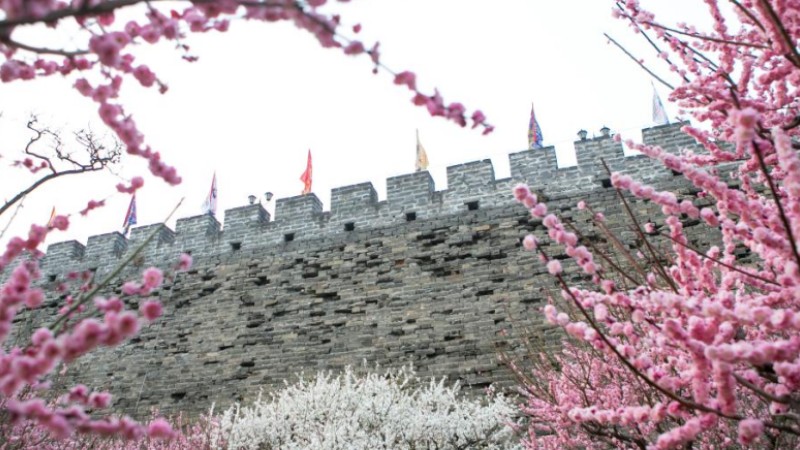China makes solid progress in the protection of its water resources
BEIJING, March 22 (Xinhua) -- Every year, millions of birds stop to rest at the estuary of the Yellow River during their migration, with some choosing to stay for the winter and to breed.
High above the 153,000-hectare river delta located in Dongying, east China's Shandong Province, vast areas of fiery red Suaeda salsa house hundreds of bird species, including rare oriental white storks.
Such sights are common in China as the country has taken solid steps to protect its water resources and restore harmonious ecological systems.
China now has clearer rivers and lakes, and birds and dolphins are reappearing. The country will celebrate the 31st World Water Day on March 22 and the 36th China Water Week from March 22 to 28 through remarkable achievements and concrete measures.
LUCID WATERS
Clear waters are crucial to China's environmental protection work. The country in 2018 vowed to tackle air, water and land pollution, and has achieved satisfactory outcomes over the past years, with continued pollutant discharge declines and improved water quality levels.
Good-quality surface water -- at or above Grade III in China's five-tier system -- accounted for 87.9 percent of the country's total last year, up from 67.9 percent five years ago.
All the main streams of the Yangtze River, the country's longest waterway, have had Grade-II-quality water for three consecutive years, and the Yellow River, China's second-longest waterway, tested at the Grade-II level for the first time in 2022.
Two main parameters for water pollution -- chemical oxygen demand and ammonium nitrogen -- respectively dropped 3.7 percent and 5.5 percent year on year in 2022.
China has implemented its "river chief" system, launched its "mother river" restoration program, and controlled the excessive exploitation of groundwater, Minister of Water Resources Li Guoying said when highlighting the importance of water protection measures in an interview with China Daily.
"More and more bodies of water and river basins have been rejuvenated. Many rivers that were previously dry for extended periods of time once again flow," Li said.
PROTECTING "MOTHER RIVERS"
As the weather warms, birds inhabiting the Jinhu Lake wetland park in central China's Hubei Province have embraced their breeding season. Li Chaoqun, an "ecological chief," has stepped up patrols of the wetland connected to the Yangtze River in recent days.
The lake used to be polluted due to fish farming, but thanks to arduous efforts to crack down on pollution and restore the local ecology, it has become a beautiful back garden of the Yangtze River, Li said.
The changes happening at Jinhu Lake have showcased China's great endeavors in the conservation of the Yangtze River and the Yellow River.
Two years ago, China put into effect the Yangtze River Protection Law, the first piece of legislation for a specific river basin, and has seen positive progress.
In 2021, 97.1 percent of Yangtze River segments had excellent or good quality water. A 10-year fishing ban launched in 2021 has increased populations of rare aquatic creatures, including Yangtze finless porpoises, an endangered species known as the "giant panda of the water."
The conservation of the Yellow River, which supplies water to 12 percent of China's population and irrigates 17 percent of its arable land, is also high on the country's agenda.
The river that was once plagued by soil erosion has seen steady progress in the rebuilding of its ecological environment. Thanks in part to increased afforestation, the soil and water conservation rate in the basin increased from 41.49 percent in 1990 to 66.94 percent in 2020, and then to 67.37 percent in 2021.
The Yellow River Protection Law, adopted on Oct. 30, 2022, will come into force on April 1. The law will bring strong impetus to the ecological protection and high-quality development of the Yellow River basin, said Yu Qiyang, an official of the Ministry of Water Resources.
EFFECTIVE WATER GOVERNANCE
Persevering in the protection of water resources, China has improved its water governance capacity by balancing its economy and its environment.
While the Chinese economy has maintained steady growth, the country's annual water consumption has remained below 610 billion cubic meters for years. In 2022, its water use per 10,000 yuan of GDP dropped 46.5 percent from 2012 and its water use per 10,000 yuan of industrial added value fell 60.4 percent.
With intensified environmental protection efforts on the Yangtze River, the river's economic belt has remained vibrant, contributing 46.6 percent of the country's total economic output in 2021.
China's improved water resource management can also be seen in the supply of water to areas and people in need.
Over 60 billion cubic meters of water have been transferred from major rivers in the south of the country to the drought-prone north, benefiting more than 150 million people through a large water diversion project. The project's first two routes started operations in 2013 and 2014, respectively, with a third in the planning stage.
The country's household water supply has also been ensured further, with 87 percent of China's rural population now having access to tap water, up from 65 percent in 2012.
Photos
Related Stories
Copyright © 2023 People's Daily Online. All Rights Reserved.









